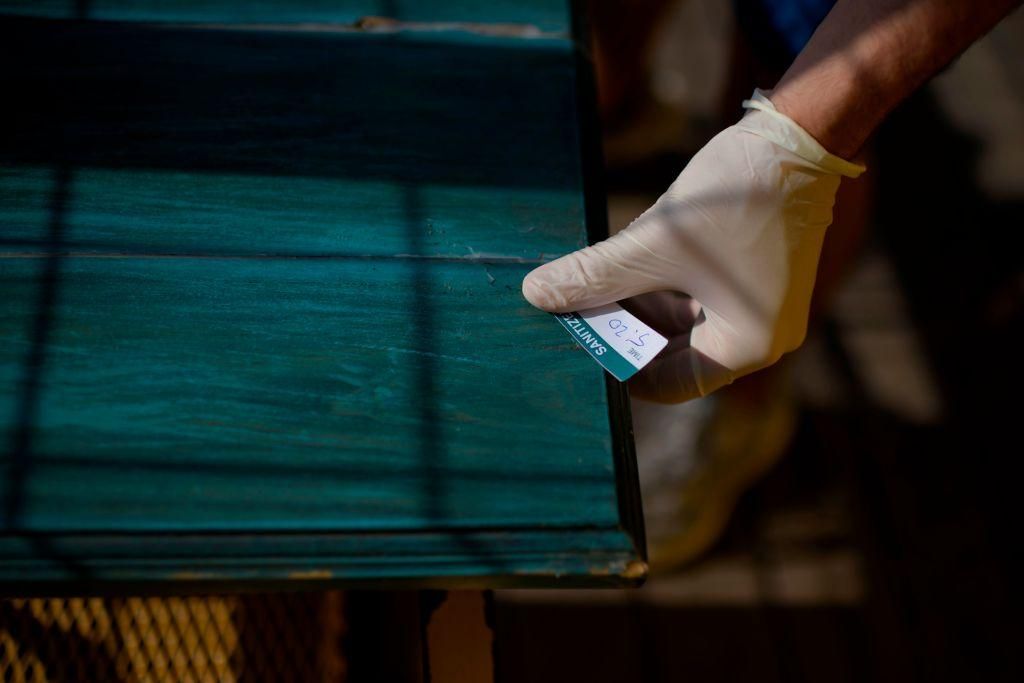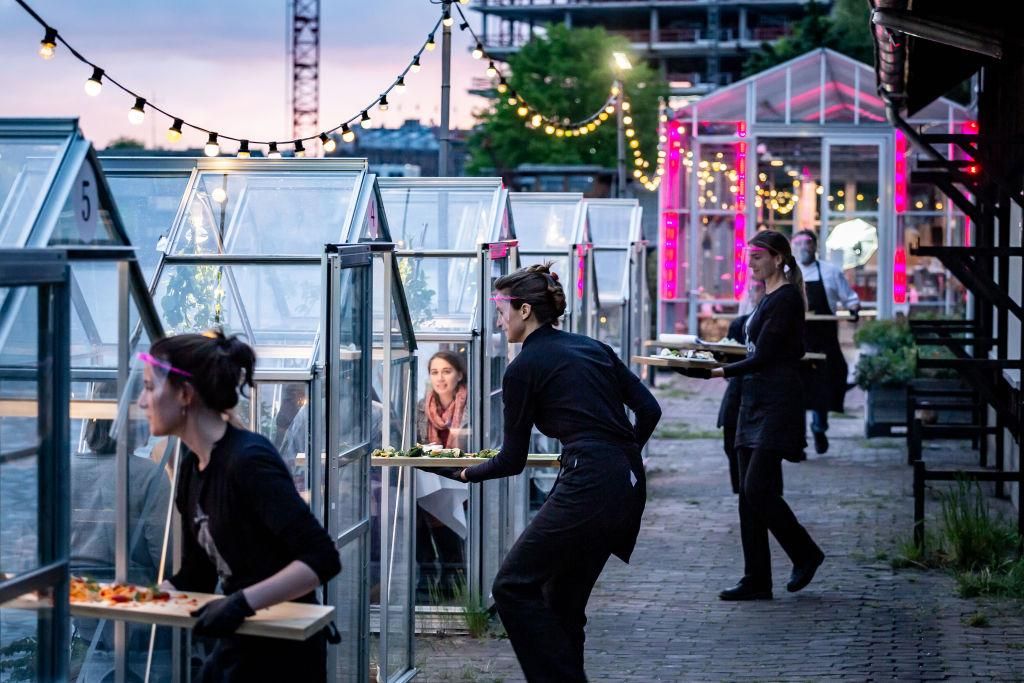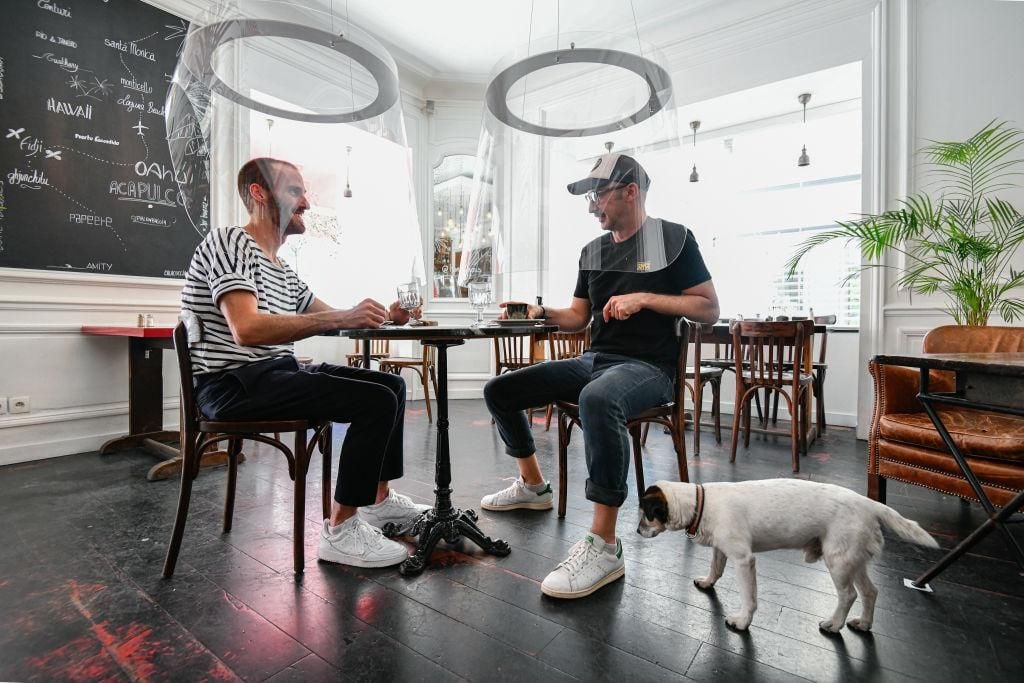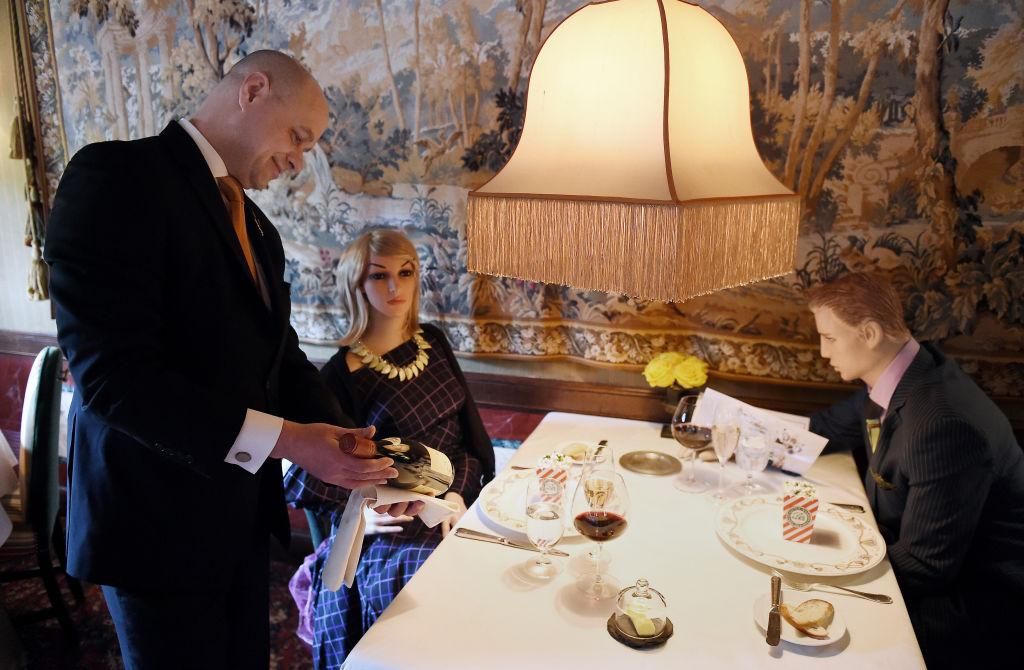The New Normal of Dining Out
Restaurants and bars worldwide are instituting unique safety measures against the spread of COVID-19. But will they be effective?
/https://tf-cmsv2-smithsonianmag-media.s3.amazonaws.com/filer/ee/f8/eef80018-93f7-43de-afb2-fea299e2a243/social_distancing_sign__london_drugs_49684963711.jpg)
It’s official—the threat from COVID-19, though continually present, is somewhat waning: infection rates are decreasing in the United States. Now, states and other countries are grappling with the after-effects on their economies and how to begin opening things up without facing a resurgence of cases. As of this writing, restaurants in only three remaining states (Massachusetts, New Jersey and New York) are still closed completely; every other state has opened restaurants for either indoor or outdoor dining with restrictions.
As many cities enter the reopening phase allowing restaurants to operate, they must move forward working with reduced capacity and public safety rules. Some spots are getting particularly creative about how they meet these requirements.
Socially-Distanced Dining
For Fish Tales, a pub and seafood spot in Ocean City, Maryland, diners get a meal with a taste of bumper cars. Owner Shawn Harman commissioned bumper tables for his customers—round tables with a hole in the middle for one person and a bouncy inner tube around the edge. They’ve got wheels on them, so diners can roll around the patio and say cheers and hello from a socially appropriate distance.
Jaline Gerardin, assistant professor of preventive medicine (epidemiology) at Northwestern University’s Feinberg School of Medicine, says that although the bumper tables are a unique—and possibly fun—idea, it does have a bit of riskiness to it. “You could be talking and generate infected droplets, then have those land on someone else’s bumper table,” she says.
It’s better to keep a larger distance between people at restaurants, even when dining outside. To that end, outdoor dining chugs on with unique circumstances at Clarity, a New American restaurant in Vienna, Virginia, where chef Jonathan Krinn is transforming his parking lot into a reservation-only drive-in dining experience. He’s got 16 dining spots set up nine feet away from each other, with a maximum of two people per spot or four people if it’s a family. Once diners arrive, a fully sanitized table setting comes out, including table and chairs under a tent. They’ll be served an $80 five-course meal. Some cities—like Chicago, Madison, Tampa, Cincinnati, Atlanta and more—have acted or plan to act on governors' orders to shut down parts of certain streets in order to allow expanded patios for outdoor dining, in leiu of indoor spots. And as of this month, the Mediamatic Eten restaurant in Amsterdam is seating their diners canalside in private glass greenhouses. They’re all enclosed with a sliding door and can fit two diners and a table. The interior of each greenhouse is just for customers—waitstaff serves their food on long wooden planks slid onto the table through the sliding door entrance.
“Since they’re completely enclosed and the booths are being sanitized in between, it seems like they’re trying pretty hard to prevent diners from infecting staff and infecting other diners,” Gerardin says of the greenhouses. “That might be a little more effective [than other solutions].”
Indoor dining is a whole different set of circumstances, but restaurant owners are no less creative in their anti-coronavirus methods. Breakfast restaurant Twisted Citrus in North Canton, Ohio, plans to open with clear plastic shower liners separating each table. Gerardin says the method may be completely ineffective unless there’s a way to clean the liners that accounts for their floppiness; otherwise the virus will survive on parts that didn’t get cleaned. Throughout South Korea, government-mandated hard transparent plastic dividers are up between dining tables in dining halls and cafeterias. Meanwhile, the Parisian restaurant H.A.N.D. is demonstrating a product called Plex'eat, which is a plastic shield for individual diners that looks a bit like a giant, stemless wine glass. The three-Michelin-starred Inn at Little Washington in Virginia has perhaps one of the most unique methods for reopening: The chef is filling empty tables in the restaurant with life-size mannequins dressed in 1940s-era clothing. The servers must interact with the mannequins as if they were guests—bringing them wine and asking about their day so far. It’ll be just like a crowded restaurant, except half the people in it are fake. Similarly, a restaurant in Japan’s Izu Shabonten Zoo fills every other seat with a stuffed capybara.
“Part of the issue is that if you’re going out to eat with a group or even one other person, it’s a social event,” Gerardin says. “You’re talking, eating and breathing, and you’re not wearing a mask. If you then add an enclosed area, that’s three not-so-great things put together. If you did all this outside versus inside, would that mean your risk goes to zero or a small number? I don’t know. I don’t think anyone knows the impact of Cloroxed shower curtains, or barriers, or bumper tables.”
Capacity Limits
Across the world, most restaurants are opening with updated capacity rules, but those vary from place to place—ranging from places with no limitations at all like Alaska, to 30 percent capacity and tables eight feet apart, as in Delaware. In Chicago, when restaurants finally reopen for indoor dining, they’ll be operating at 50 percent capacity maximum. Virginia restaurants also have to be at 50 percent capacity, hence the mannequins and the drive-in. Some spots are only allowed to have a certain amount of people inside at once, like at Twisted Citrus, where seating capacity is down to 55 instead of 80, to accommodate the extra safety measures put in place. And in Milwaukee, some restaurants are only opening for 20 people at a time—even though Wisconsin has abolished any sort of distancing rules.
Capacity rules are good but not a cure-all, Gerardin says. It’s much better to be outside. She spoke of one super-spreader event in China, where one infected person was sitting in the air conditioning flow, and everyone else in the flow behind them got infected as well. Those not sitting in the air conditioning’s path didn’t get infected. But if you have less people inside, it’s not as severe a problem as it could be.
“If you’re going to have a super-spreader event where everyone gets infected and you have 50 people in the restaurant instead of 200 people, you’re dealing with a smaller problem,” Gerardin says. “It still sucks for those 50 people, but it’s a smaller amount. When you’re doing your contact tracing or thinking about the burden on health system capacity, it’s that many fewer people for you to chase down or care for.”
Ordering
Technologies for contactless ordering and digital payment are on the rise, as many restaurants shirk cash payments due to the germs that could be transmitted while paying. For the majority of restaurants around the country, that looks like credit card payments, ordering on an app or touch-free tablet or using digital payment systems like Apple Pay, where you simply hold your phone near the register system. But some spots are coming up with more innovative ways to tackle ordering problems. The soon-to-open Brooklyn Dumpling Shop in New York City will operate on an automat system, putting finished orders into a glass locker that diners can unlock with their phones—it's a vending machine concept but for freshly prepared food.
Sanitizing

Sushi robots are rumored to be growing in popularity, cutting down on the time (and hands) necessary to place and receive an order. With less people touching your food, you'll need to worry less about virus transmission. Other sanitation measures are being put in place as well, to ensure the cleanliness of restaurants and the health of their customers. Magnolia Bakery in New York, Cameo Pizza in Ohio and Cien Agaves in Arizona, to name a few, are all using UV light to sanitize both entering people and the restaurants themselves. Across the country, diners are getting temperatures checked when they walk into a restaurant—Brooklyn Chop House in New York, for example, retrofitted metal detectors to scan temperatures instead—and some restaurants, like Madison Chop House Grille in Georgia, have employees recording their temperatures on whiteboards that every customer can see. In Houston, one restaurant owner is putting time-stamped stickers on tables after they've been cleaned so diners know the space is sanitary. Other sanitary touches include bottles of hand sanitizer placed throughout restaurants, suspended buffets in favor of à la carte ordering, limited drink refills, and utensils and napkins placed outside of customer reach.
Staff Rules
Even with lower capacity limits, the rules for restaurant staff are murky. Ideally, restaurant owners would operate a large enough kitchen to allow staff members to keep a six-foot distance from one another, but that’s often not possible in cramped kitchen spaces of smaller eateries. At this point, it’s difficult to find hard and fast rules for staff at a newly reopened restaurant. The CDC suggests continued use of masks and gloves when interacting with customers, and some states, like Colorado, have drafted initial rules suggesting that restaurants stagger shift times to allow for staff to have the least amount of contact with customers and among themselves. Ultimately though, social distancing could be a big concern in restaurant operations.
“Handwashing and best practices for food safety are also best practices for COVID, so it’s important that people continue to do those, especially if physical distancing isn’t going to be an option,” Gerardin says. “Masks are going to be really important. But I can imagine wearing a mask in a hot kitchen, you’d be even hotter. It could get really sweaty and you’d feel gross and want to be fixing it all the time. So [safety rules] could be something like having huge piles of fresh masks for people so they can swap them out every so often for fresh ones.”
Ultimately, Gerardin says, the safest and healthiest route for now is really to keep restaurants closed—but there needs to be a balance to keep the economy in mind.
“Could opening outdoors be a reasonable compromise that doesn’t cost us too much in terms of public health impact but would give us substantial gains in economic impact?” she asks. “It’s a trade where we have more idea of what will happen on the economic side and a little bit less idea of what would happen on the public health side. What’s really important is that we have systems in place so if there is an uptick in cases and transmission, we’re able to detect that as soon as possible and reconsider our decisions.”
/https://tf-cmsv2-smithsonianmag-media.s3.amazonaws.com/accounts/headshot/JenniferBillock.png)





/https://tf-cmsv2-smithsonianmag-media.s3.amazonaws.com/accounts/headshot/JenniferBillock.png)